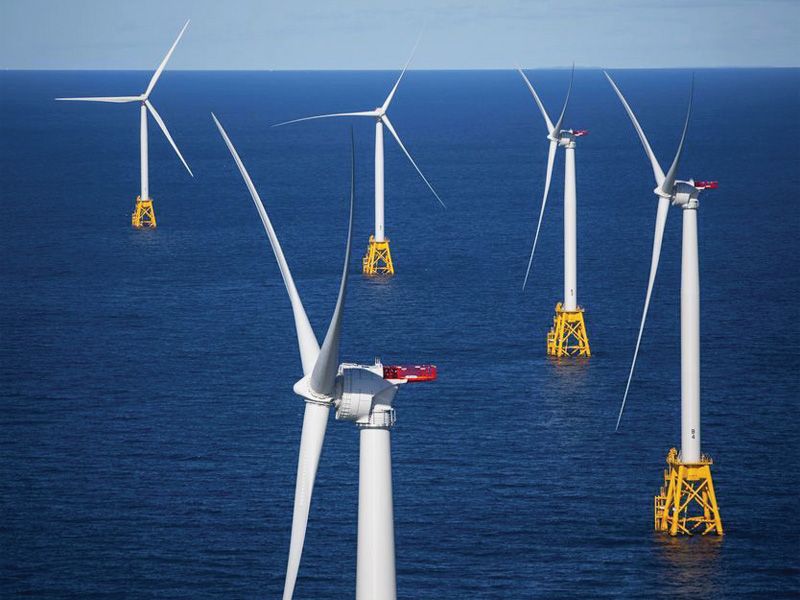For the Atlantic states, offshore wind power might be the next energy boom.
Back in 1859 the Drake Well, located in appropriately named Oil Creek, Pennsylvania in the corner of the state near Lake Erie, was successfully drilled by Edwin Drake and set off the first oil boom in U.S. history and launched the hydrocarbon era of industrial power. Now to the East, the Atlantic Ocean may hold the key to the next great energy boom.

On June 20th, temperatures in the Siberian hamlet of Verkhoyansk topped 100 degrees – a record high for the region. On that day, Verkhoyansk was hotter than Veracruz. With such obvious alarming weather trends, the need to reduce carbon is high on the agenda of nearly every country in the world. For example, even in the middle of the pandemic the Prime Minister of the UK, Boris Johnson, announced a plan for $446 million in funding to cut greenhouse gases. But the tools in the toolbox to address climate change on a large scale – especially in the industrial world – are few.
That challenge largely begins with finding ways to generate energy – especially electricity – using clean renewables. With this as a starting point, other clean technologies can be deployed. It really doesn’t do much good to switch to electric vehicles and other “clean” systems without addressing the basic issue of clean electric generation. The two main tools are wind and solar power systems (hydropower not withstanding). And of the two, wind power has emerged as the principal tool in addressing large scale clean power generation.
A report commissioned by Ocean Renewable Energy Action Coalition’s (OREAC) the Ocean Panel contends ocean-based renewable energy, such as offshore wind, floating solar, tidal and wave power, could meet nearly 10% of the global annual greenhouse gas emissions reductions necessary to remain on a Paris Climate Agreement-compliant 1.5°C pathway for 2050. OREAC estimates upwards to 85% of this decarbonisation potential will come from offshore wind. And globally offshore wind power has been growing rapidly. In 2009 the global offshore wind energy capacity was 2,134 megawatts and by 2019 had grown to over 28,300 gigawatts.
US Wind Power Gathers Speed
While onshore power has grown rapidly in the U.S.– from 6,737 gigawatts generated in 2001 to over 300,000 gigawatts generated in 2019 - offshore wind power has lagged behind contributing only a trickle from the wind farm off Block Island. But that is changing as states in the Northeast of the U.S. are preparing for what could become one of the world’s great energy booms.
Back in June, New Jersey’s Governor Phil Murphy announced the State’s plans to build the first purpose-built port for serving the budding offshore wind power industry. The project dubbed “The New Jersey Wind Port” would be located on Artificial Island in a 200-plus-acre facility in Lower Alloways Creek Township in Salem County, near the PSEG’s (Public Service Enterprise Group) nuclear power plants. The project, the first of its kind in the nation, is designed to make New Jersey “the capital” for offshore wind power on the U.S. East Coast. Construction could begin as early as the first quarter of 2021, with the project estimated to cost between $300 million and $400 million
The NJEDA (New Jersey Economic Development Authority), the principal State organization for offshore wind development, outlined that the construction is planned in two phases, beginning in 2021. Phase 1 will develop a 30-acre site to accommodate marshaling activities and a 25-acre component manufacturing site. Phase 2 adds another 150-plus acres to accommodate expanded marshaling activities and extensive manufacturing facilities for turbine components, such as blades and nacelles.
Wind Energy Futures
Even before the “New Jersey Wind Port” pronouncement, Governor Murphy had a plan to develop offshore wind to meet the 7,500 megawatt (MW) target by 2035 as part of a program to meet New Jersey’s state goals of 50% renewable energy by 2030 and a 100% clean energy economy by 2050.
But the New Jersey program is part of an even wider trend as the Northeast corridor states from New England to the Mid-Atlantic, are betting their energy futures on the development of offshore wind power. The US EIA (Energy Information Agency) believes “Offshore wind is set to be a $1 trillion industry over the next two decades, but the promise of growth hinges on government policies and industry strategies.”
While the Trump Administration seems lukewarm at best to supporting wind power (and most renewables) at state level those strategies for offshore wind are clear.
In 2019, New York’s Governor Andrew Cuomo, inked agreements for two offshore wind projects for nearly 1,700 megawatts. The agreements were an essential part of the New York state plan to mandate 9,000 megawatts of clean energy by 2035. Earlier this year, Virginia passed the Clean Economy Act, requiring the state to eliminate all carbon from its electricity supply by 2045. The new legislation includes a 5.2-gigawatt offshore wind target for 2034, putting Virginia behind only New York and New Jersey in current state offshore wind mandates. Virtually every Atlantic state from Maine to Virginia has their oar in the offshore wind business.
Wood Mackenzie, an energy consultancy firm, forecasts that “in 2024, offshore wind will comprise over a third of the year’s wind capacity installations in the U.S., increasing to close or even half of the wind build in each subsequent year to 2029.”
The consultancy company believes in New England and New York, a full 80% of wind build through 2026 will be located offshore.
To be sure there are hurtles both technical – connecting to the existing grid – and political (as various groups ranging from seaside landholders to fisherman have opposed the building of offshore wind farms. But there are other options with as much potential as offshore power for addressing the clean energy demands of the heavily populated Atlantic Northeast.





